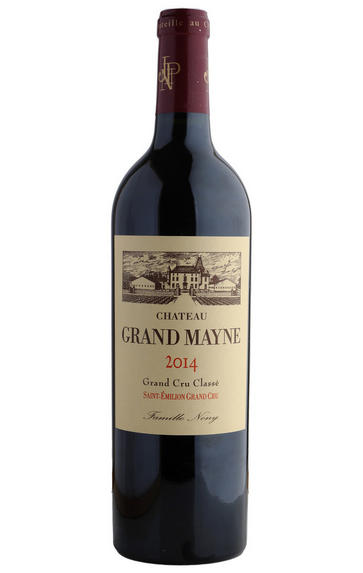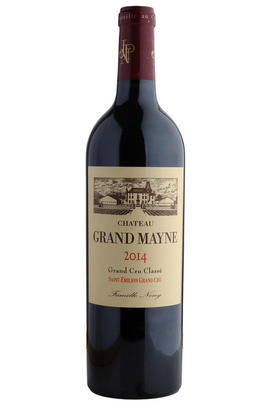
2014 Château Grand Mayne, St Emilion, Bordeaux

Critics reviews
The 2014 Grand-Mayne has a light fleshy red berry bouquet with crushed strawberry and raspberry. There is impressive delineation and focus in situ. The palate is medium-bodied with fine-grain tannin and a crisp line of acidity. This Saint-Émilion is nimble on its feet, something you might not ascribe to older vintages of Grand-Mayne, with a fresh mineral-driven finish. This is one of Jean-Antoine Nony's best wines in recent years. Tasted blind at the annual Southwold tasting.
Drink 2020 - 2040
Neal Martin, vinous.com (Mar 2018)
The 2014 Grand Mayne is quite powerful, but also closed and far less expressive than it was from barrel. Dark red cherry, rose petal, mint, cedar and spice give the wine striking aromatic delineation, but the 2014 needs time in bottle for the tannins to soften. There is good potential here. Tasted two times.
Drink 2019 - 2026
Antonio Galloni, vinous.com (Feb 2017)
The 2014 Grand-Mayne has a fragrant bouquet, perhaps more refined than in recent years with dried rose petals and incense fusing with the red berry fruit. The palate is medium-bodied with fine tannin, crisp acidity and a gentle build towards a vivid, lightly spiced finish that maintains impressive delineation, perhaps less extracted and more precise than wines of the past. This is a superb Grand-Mayne that represents a subtle change in tack for the estate—one that this writer approves of. Tasted on three occasions and consistent every time.
Drink 2020 - 2040
Neal Martin, Wine Advocate (Mar 2017)
Lovely fruit clarity here – bold, sweet but not confected – pure pleasure. Then the palate is surprisingly fierce in tannin, giving a grainy, mouth-coating texture. While the fruit is very tempting to drink now, this is one to lay down for a rainy day.
Drink 2020 - 2034
Richard Hemming MW, jancisrobinson.com (Nov 2016)
The sweet plum-cake aromas match the rich — almost creamy — entry, then the crisp acidity comes through. The dry tannins are a little challenging, but there’s a lot of depth. Needs some time to soften. Try in 2019.
James Suckling, jamessuckling.com (Feb 2017)
Creamy fruit. Supple texture. Little more tender this year. Finely woven tannins. Persistent finish.
Drink 2020 - 2032
James Lawther MW, Decanter.com (Apr 2015)
About this WINE

Chateau Grand Mayne
Château Grand Mayne sits at the heart of the St Emilion appellation on Bordeaux’s Right Bank. The 17-hectare vineyard has remained unchanged for 300 years or so. Brothers Jean-Antoine and Damien Nony are the third generation of their family at the helm here. Their late father, Jean-Pierre, sadly passed away in 2001, aged just 55. The most prized part of the vineyard is a slope of limestone over clay. “My father used to call it his Romanée-Conti,” Jean-Antoine recalls. “It looks like a Burgundian Grand Cru.”
As recently as the 1960s, there was around 40% Cabernet Franc planted here. Over time, it dropped to 10-15% of the plantings. When Jean-Antoine took over in 2012, he initiated a replanting programme, now underway and due to be completed in 2035. The estate has been a Grand Cru Classé since 1955.

St Émilion
St Émilion is one of Bordeaux's largest producing appellations, producing more wine than Listrac, Moulis, St Estèphe, Pauillac, St Julien and Margaux put together. St Emilion has been producing wine for longer than the Médoc but its lack of accessibility to Bordeaux's port and market-restricted exports to mainland Europe meant the region initially did not enjoy the commercial success that funded the great châteaux of the Left Bank.
St Émilion itself is the prettiest of Bordeaux's wine towns, perched on top of the steep limestone slopes upon which many of the region's finest vineyards are situated. However, more than half of the appellation's vineyards lie on the plain between the town and the Dordogne River on sandy, alluvial soils with a sprinkling of gravel.
Further diversity is added by a small, complex gravel bed to the north-east of the region on the border with Pomerol. Atypically for St Émilion, this allows Cabernet Franc and, to a lesser extent, Cabernet Sauvignon to prosper and defines the personality of the great wines such as Ch. Cheval Blanc.
In the early 1990s there was an explosion of experimentation and evolution, leading to the rise of the garagistes, producers of deeply-concentrated wines made in very small quantities and offered at high prices. The appellation is also surrounded by four satellite appellations, Montagne, Lussac, Puisseguin and St. Georges, which enjoy a family similarity but not the complexity of the best wines.
St Émilion was first officially classified in 1954, and is the most meritocratic classification system in Bordeaux, as it is regularly amended. The most recent revision of the classification was in 2012

Cabernet Sauvignon Blend
Cabernet Sauvignon lends itself particularly well in blends with Merlot. This is actually the archetypal Bordeaux blend, though in different proportions in the sub-regions and sometimes topped up with Cabernet Franc, Malbec, and Petit Verdot.
In the Médoc and Graves the percentage of Cabernet Sauvignon in the blend can range from 95% (Mouton-Rothschild) to as low as 40%. It is particularly suited to the dry, warm, free- draining, gravel-rich soils and is responsible for the redolent cassis characteristics as well as the depth of colour, tannic structure and pronounced acidity of Médoc wines. However 100% Cabernet Sauvignon wines can be slightly hollow-tasting in the middle palate and Merlot with its generous, fleshy fruit flavours acts as a perfect foil by filling in this cavity.
In St-Emilion and Pomerol, the blends are Merlot dominated as Cabernet Sauvignon can struggle to ripen there - when it is included, it adds structure and body to the wine. Sassicaia is the most famous Bordeaux blend in Italy and has spawned many imitations, whereby the blend is now firmly established in the New World and particularly in California and Australia.


Buying options
Add to wishlist
Description
The 2014 Grand-Mayne has a light fleshy red berry bouquet with crushed strawberry and raspberry. There is impressive delineation and focus in situ. The palate is medium-bodied with fine-grain tannin and a crisp line of acidity. This Saint-Émilion is nimble on its feet, something you might not ascribe to older vintages of Grand-Mayne, with a fresh mineral-driven finish. This is one of Jean-Antoine Nony's best wines in recent years. Tasted blind at the annual Southwold tasting.
Drink 2020 - 2040
Neal Martin, vinous.com (Mar 2018)
wine at a glance
Delivery and quality guarantee